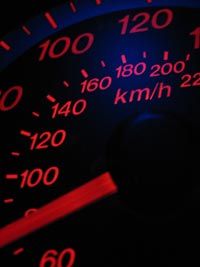Eddy-Current Speedometer Parts
Before we take a look inside a speedometer, it will be helpful to review how a car works in the first place. The basic process is described below:
- Piston engines use energy from a burning fuel-air mixture to move a piston up and down in a cylinder.
- This reciprocating motion of the pistons is converted into rotary motion by a crankshaft.
- The crankshaft turns a flywheel.
- The transmission transmits power from the flywheel and directs it, through a driveshaft, to the wheels.
- The transmission has different gears— or speeds— to control how fast the wheels turn.
- As the wheels turn, they cause the car to move.
To measure the speed of a car, one must be able to measure the rotational speed of either the wheels or the transmission and send that information to some sort of gauge. In most cars, measurement takes place in the transmission. And the job of measuring the rotational speed generated by the transmission falls to something called a drive cable.
Advertisement
The drive cable consists of a number of superimposed, tightly wound, helical coil springs wrapped around a center wire, or mandrel. Because of its construction, the drive cable is very flexible and can be bent, without fracture, to a very small radius. This is handy because the cable must snake its way from the transmission to the instrument cluster, which houses the speedometer. It is connected to a set of gears in the transmission, so that when the vehicle moves, the gears turn the mandrel inside the flexible shaft. The mandrel then communicates the rotational speed of the transmission down the length of the cable to the "business end" of the speedometer— where the speed measurement actually takes place.
The speedometer has other important parts, as well. The drive cable attaches, via a spiral gear, to a permanent magnet. The magnet sits inside a cup-shaped metal piece known as the speed cup. The speed cup is attached to a needle, which is held in place by a hairspring. The needle is visible in the cockpit of the car, as is the speedometer face, which displays a range of numbers from zero to an upper limit that can vary by make and model.
Now let's look at how this relatively simple device actually measures vehicle speed.
